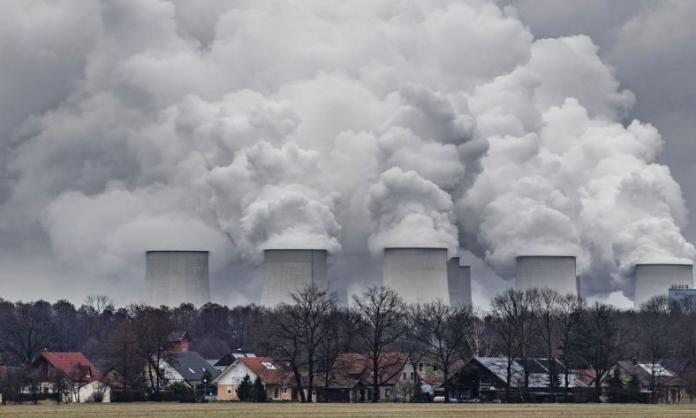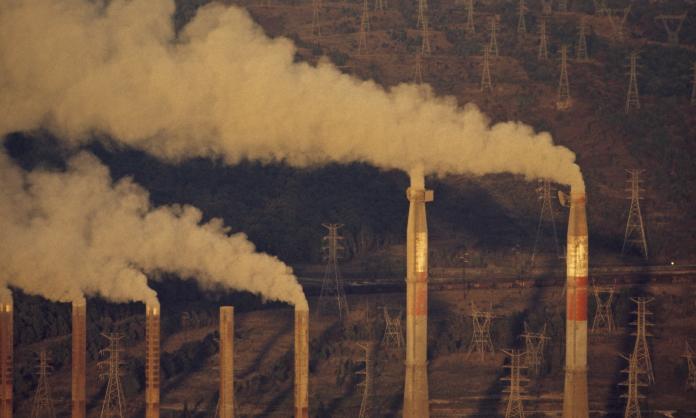Is Germany a good example of a ‘just transition’?
All the fire, ash and death of this Australian summer, the record breaking droughts, the terrifying heat waves – these are the product of a global temperature increase of about one degree above the long term average.
If every single country meets its commitments to reduce greenhouse gases under the Paris climate agreement (which they won’t), we’ll get more than three times this level of heating. If “apocalypse” was the most used word of the Australian summer, there are no words for what comes next in this scenario.
If we want to limit global temperature rises to “only” 1.5 degrees, we have to cut global greenhouse gas emissions dramatically and immediately: by 7.6 percent each year for the next decade, according to the overwhelming majority of the world’s climate scientists.
And if there’s one country that should be leading this transformation, it is the enormously productive and technologically advanced economy of Germany. Germany’s rollout of large-scale wind and solar power seems to stand in stark contrast to the pathetic effort of Australia’s coal-addicted political establishment.
Germany’s program to phase out the coal industry by 2038, legislated last year, has been the subject of renewed interest in the Australian media in recent weeks, led by the ABC’s Foreign Correspondent program. The final closure of Germany’s black coal industry in 2018, the subject of Sydney Morning Herald headlines proclaiming “How Germany closed its coal industry without sacking a single miner”, has led many in the climate movement to hope this might serve as a potential model for a “just transition” from fossil fuels to the new green economy.
Unfortunately, it’s mostly bullshit.
********
Germany has stopped mining black coal – but it certainly hasn’t stopped using it. Around 12 percent of electricity in Germany is still produced by burning imported black coal. Even when this is phased out (supposedly in 2036), black coal imports will continue at almost half the current rate, to fuel Germany’s steel industry (the world’s fifth largest).
While the technology exists to make steel without coal – using hydrogen or electrolysis – around the world there are only a handful of pilot projects pushing this technology towards commercial application. These pilot plants have a reported value of between US$70 million and $150 million each. For an industry that claimed $US2.5 trillion in sales last year, this barely rates as even a token effort at decarbonisation.
One source of Germany’s coal imports is the notorious Cerrejon mine in Colombia, jointly owned by coal giants BHP, Glencore and Anglo-American. Deaths from malnutrition among communities displaced by the Cerrejon mine are common. Protests are frequent, and the local Wayuu indigenous people and the coal miners’ union face violence and threats when they make common cause against BHP and its joint venture partners. Colombia regularly sets records for the number of union activists killed.
So to the extent that coal mined in Germany has been replaced by coal mined at Cerrejon in Colombia, this represents a “transition” from tightly regulated, high wage coal mines in Germany to a blood-soaked, low cost industry in Colombia. This is no model at all for a just transition.
Coal imports from the USA, courtesy of the brutal but cheap mining method known as “mountaintop removal”, and from Russia (especially Siberia) at a massive human and environmental cost, are not much better. The Coal Action Network and forest conservation group Fern talked to villagers in Siberia near open cut coal mines fuelling the export trade to Europe. Residents commonly find 10cm of coal dust remains when the winter snows melt. “The coal industry is choking people out of the region; soon we will be like rats, leaving a sinking ship”, resident Valentina Microchina said.
German capitalism loves to celebrate its clean hands and green technology – but a large part of this effect is created by outsourcing the dirty, bloody work of coal extraction to others.
Germany today remains the world’s largest producer and consumer of brown coal, a wet and more polluting form of coal, which fuels over 20 percent of electricity production. The main effect of the coal exit plan is to gradually close these mines, and the power stations that they fuel, over the next two decades.
It’s an attractive idea that Germany’s black coal industry was shut down without sacking a single miner. In any sane society, this is exactly what would happen – workers would be retrained and redeployed into other vital industries without loss of pay.
But this is not what happened to Germany’s black coal industry. Most of the coal mining workforce was sacked or pushed into early retirement from the 1970s onward, as German capitalism shifted to cheaper imported coal. And any journalist able to google should be able to turn up news photos of coal miners laid off from Prosper-Haniel, the last operating mine, demonstrating on their way to the unemployment office in the town of Bottrop in June 2019.
It is true that, by the dog eat dog standards of world capitalism, Germany’s black coal miners were cushioned from many of the worst impacts of being thrown on to the scrapheap. In 2007, when the German government decided to end subsidies for the rapidly shrinking black coal industry and shift entirely to imports, it made provision for around 90 percent of the black coal industry’s ageing workforce of 32,000 to take early retirement (for every miner aged 50 or more at the time of closure), with the remaining 3,000 younger workers given retraining and help finding a job.
The Ruhr valley was once the centre of German coal and heavy industry, where the last operating black coal mine was located. It’s part of a massive urban conglomeration with a diversified economy – quite different to the north-east of England or the West Virginia coal district, where coal was still the dominant industry at the time the mines were shut or mechanised. And in Germany, state and federal governments put substantial money into the former coal communities. The town of Bottrop, for instance, has been lavished with urban redevelopment, residential refurbishment and green energy initiatives.
Reports vary as to how much impact these programs have had. But a Public Radio International report notes: “The former mining city of Gelsenkirchen is the poorest city in Germany. In the three-city region that includes Gelsenkirchen and Bottrop, unemployment rates come in at 11 percent — twice the national average”.
It’s not entirely clear what will be the fate of the 10,000 workers in coal-fired power stations in Germany today, and the 20,000 still working brown coal miners. A long lead time certainly allows for retirement and retraining. And the German government has pledged €40 billion up to 2048 in remedial payments to the state governments of the areas most affected – about the same amount the government paid in subsidies to the coal companies over the past 20 years.
Many in eastern Germany, where most of the brown coal mines are located, are understandably cynical about how much of this compensation money will come their way, having seen the collapse of employment after unification in 1990. The tragedy is that the approach of the coal miners’ union has been to line up with the coal bosses to try to preserve an industry that has to go – for the sake of the entire worldwide working class, including the miners themselves – rather than use their very substantial industrial power right now to win a just transition worthy of the name, and a dramatic and rapid transition, not one drawn out over 18 polluting years that the world can’t afford.
********
To the extent that the slow phasing out of coal creates a gap in the German energy market, a large part of this gap is due to be filled, for the next decade at least, by another fossil fuel – natural gas. German economy minister Peter Altmaier announced late in 2019, “Natural gas will remain an important element of our energy supply system for many years”. New gas importation hubs are to be built on the Baltic sea, and the massive Nordstream 2 pipeline from Russia is approaching completion.
The gas industry and its champions, including such willing tools of the fossil fuel industry as Scott Morrison, claim that gas is a “transition fuel” between other fossil fuels and renewables. However, this claim has come under increasing dispute in recent years.
Generating electricity by burning gas does indeed produce only half the emissions of coal. However, “fugitive emissions” (leaks) of natural gas are a huge issue. Methane, the main component of natural gas, is a massively effective greenhouse gas, with 86 times the heating effect of CO2 (measured over 20 years). So with leaks estimated at between 1 and 9 percent of total gas output, it’s arguable that a transition to gas might actually be a step back.
********
“Bioenergy”, which incredibly makes up almost half of all energy claimed as “renewable” in Germany, is another dirty secret of the supposedly world-beating German energy transition. Bioenergy comes from agricultural waste (especially gas from cow shit), or timber or grain products used for energy in furnaces, power stations, or as a substitute for some portion of transport fuel.
Burning these fuels obviously produces CO2, which heats the atmosphere. Proponents of biofuels argue that this is fine, because growing the next round of bioenergy will suck all that CO2 back out of the atmosphere – meaning that biofuels are, supposedly, carbon neutral. This is why CO2 emissions from bioenergy are excluded in national and international emissions accounting.
However, biofuels’ renewable status is hotly disputed by many in the climate movement. The cultivation, transport and processing of biofuels produce extra greenhouse gas emissions, including nitrous oxide from the use of chemical fertilisers, which are not absorbed by growing more biofuels. As the UK-based Campaign Against Climate Change notes, “new ‘full cycle’ studies suggest that many biofuels actually cause more emissions than fossil fuel”.
Not only that, but the rapidly increasing amount of land used to grow stock for biofuels such as palm oil, soy and rapeseed increases pressure worldwide to clear forest lands for biofuels and other agriculture. Land clearance is itself a huge contributor to greenhouse emissions, especially as land that could be used to sink carbon into the soil is cleared and used for agriculture.
********
Germany’s climate change record also looks massively better than it deserves to because of another accounting trick. The international baseline for carbon emissions is set at 1990 – the year after the collapse of the Stalinist regimes in Eastern Europe, and the Berlin Wall with them, led to the reunification of Germany after nearly half a century of Cold War partition.
In the years that followed, antiquated factories and infrastructure in the former East Germany collapsed under competition from the west of Germany and Europe. Without having to do much at all – apart from letting the market rip and consigning millions of workers in the east to unemployment – Germany reduced its emissions by 16 percent in a decade.
Progress has been much slower since – a further 18 percent reduction in the 18 years following 2000. Early this year Clean Energy Wire, a news service dedicated to Germany’s energy transition, reported “the recent stagnation of emissions between 2009 and 2017”, which was followed by a 4.5 percent fall in 2018 – largely due to the extraordinarily warm winter of that year.
Last year it’s estimated there was a dramatic fall of up to 8 percent in CO2 emissions, no doubt helped along by Germany’s third warmest year on record as well as increased use of gas (and the outsourcing of any “fugitive emissions” to elsewhere). Needless to say, relying on global heating – to reduce emissions and therefore save us from global heating – is no strategy for survival.
Even with the dramatic, global-warming-assisted results of the past two years; even with Germany outsourcing the fugitive emissions from black coal mining and an increasing gas share in the nation’s energy market; even ignoring the fraud of counting bioenergy as renewable – even with all of this dodgy accounting, most commentators expect Germany to miss comprehensively its 2020 target of a 40 percent reduction from 1990 levels.
Things don’t get any better from here. The German government has an official target of a 25 percent reduction in greenhouse gases over the decade to 2030 – less than half of the cut that’s needed, according to the world’s climate scientists.
We can put this another way. Germany is the probably the best model of a just transition on offer, anywhere in the world today. It’s an advanced manufacturing and technological powerhouse, with extraordinary technical capabilities. A strong history of environmental activism – strong enough to win the phaseout of nuclear power from 2022 – is putting pressure on the authorities to look like they’re doing something.
Not only that. The giant companies that dominate Germany’s stock exchange don’t include any miners or fossil fuel companies in the top 30 (just one diversified utility that includes coal as well as wind and solar). Australia, by contrast, has seven mining or fossil fuel companies in the top 30, as well as all the international mining companies. If any major capitalist country could decisively break free of fossil fuels, surely it would be Germany.
The problem, of course, is that German capitalism has to compete against its rivals. Each bloc of capital is looking over its shoulder – fully aware of the unfolding climate catastrophe, and also fully aware that any serious attempt to address the crisis by any one capital will require a diversion of resources from boosting profit and military power. This would put that bloc at a significant competitive disadvantage, both militarily and economically. And each bloc of capital knows that in today’s increasingly vicious dog-eat-dog capitalist world, that disadvantage could prove fatal.
The result is the German “transition”: a highly profitable shift to blood-soaked imported coal dressed up as a win for the world. A raft of dodgy accounting dressed up as an effective climate strategy. A set of clean corporate hands counting profits while the world smashes through every climate record humans have known.
To break from this we need more than the German “transition”. We need a break with the logic of capital. We need wave after wave of struggle, not just settling for the pathetically inadequate “solutions” on offer. We need socialism, not capitalism painted green.











